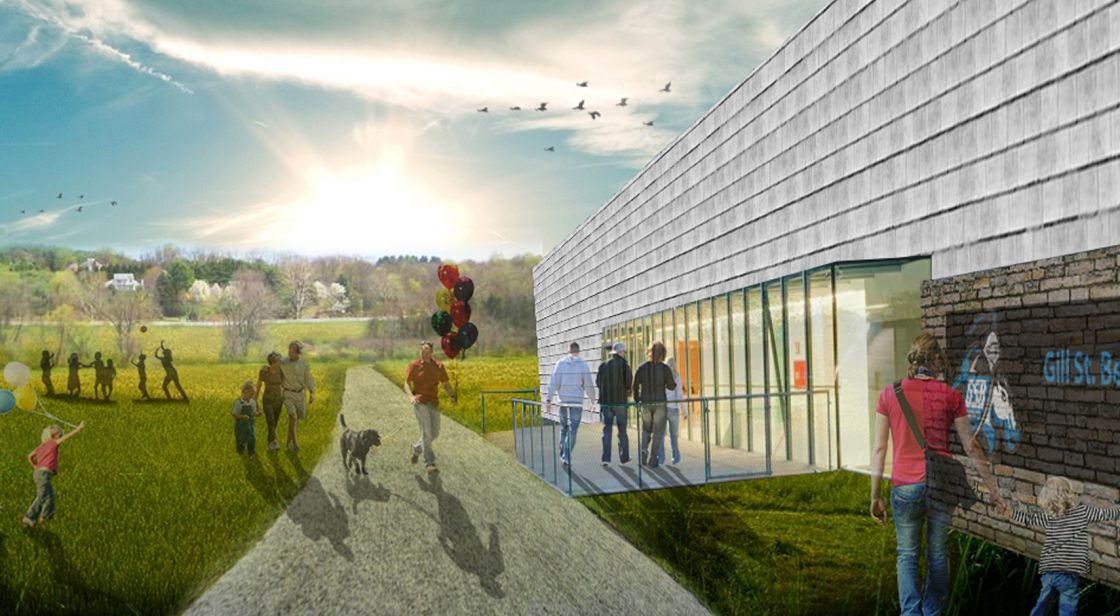In a day and age when it is a challenge for schools to preserve the value of a visual and performing arts program, it is becoming even more difficult to provide a visual and performing arts center devoted to housing these endeavors. Too often it comes down to “art on a cart” or a theatrical performance given on a temporary stage that can only be erected after lunch has finished, but must be dismantled again for a meeting that evening. These creative students and their productions may have a place to be, but they sorely lack a home in which to live and thrive. As such, as valuable as it is to offer a robust curriculum with music and the arts, it is the visible presence of a dedicated visual and performing arts center that can actually be invaluable to a school’s campus life and identity through its iconic status and vibrancy. So how to attain such an invaluable asset at an affordable, appealing price?
One solution lies in sneakers, hoops and hardwood floors – and it most likely already exists on a school’s campus: the aging yet stalwart gymnasium. Chances are that it was once built to house one or two specific sports, in use at certain times of the year. Today, a successful field house will cater to a multitude of sports, year round, while also providing the athletes within those sports the opportunity to personalize their own training regime and schedule. The truth is that the technology and training programs employed to support these athletes evolve on such a frequent basis, that an old-style gymnasium may just not be able to accommodate this degree and rate of change.
But of equal note is the major cultural paradigm shift from the pursuit of purely competitive athletics to the broader concept of recreational sports and fitness as part of an overall healthy lifestyle. Today’s students expect to be able to pursue their own fitness goals in their time and with the method of their choosing. The school’s original gymnasium, while nostalgic in memory, may no longer live up to its current-day needs. Indeed, a newer, state-of-the-art fitness center or field house may already exist on the campus or be on the campus master plan.
Here then, the worthiness of a building lies in the eyes of its beholders – can an old gymnasium, with one foot in the past, take a monumental step forward and live again in infamy? Yes. It is the perfect candidate to become a repurposed and revitalized visual and performing arts center, poised to make a new era of memories for the school.
An initial assessment of the task at hand reveals that the repurpose of an existing structure is not only fiscally responsible, but sustainably smart: instead of throwing out the old, there exists an opportunity breathe new life and a second chance into an older building. The green benefits of such a re-purposed approach: undisturbed virgin land and the saved quantities of energies and materials – are equally matched by the other “green” benefits – the reality that the refit of an existing building is far more cost effective than starting anew.
An obvious further advantage is that the size and shape of a gymnasium naturally lends itself to reuse as a performing arts center. A large clear span, high bay space translates into a robust seating area for patrons in front of the curtain, with views unobstructed by columns and work space for students, staff and equipment behind it. The height of a typical gym enables the possibility to build-in or add a fly tower for the staging and storage of large scenic backdrops. And this largeness of scale also allows for the easy installation of lighting, rigging, cat walks and any other equipment or mechanics that may be necessary to the operation of the facility.
Additionally a gymnasium is likely to have limited daylight to interfere with theatrical lighting and no columnar supports to obstruct audience sight lines; characteristics which deems it primed to become a theater. Indeed, a gymnasium’s inherent utilitarian shape promotes a “multiple end-use” approach to the re-fit plan. Having reached an optimum acoustic solution, the newly transformed space can be used not only for performances and recitals, but also for classes, lectures and event space. The once diamond in the rough now becomes a clever, elegant jewel in the crown of the school campus.
And it is this physical transformation that leads, literally, to what may be the greater value of an existing gymnasium – that of its location. Athletic centers tend to be in a common-area zone on campus, along existing circulation corridors. The students know where they are, how to get there, and already spend time there. A re-purposed gymnasium benefits greatly from its previous user’s intuitive, logical behavior. Just as the gym has been a meeting place for athletic classes, intramural sports and interscholastic competition, so will the new visual and performing arts center be a meeting place for creative instruction, performance, expression and inspiration.
This old yet new destination takes on a vibrancy from its size, location and its constant use. It is designed to be used during the day and the night, the weekday and the weekend. It is rebuilt to be a source of knowledge, pride and lasting memory. And ultimately, it can be used to build a bridge to and a relationship with the school’s local community. By attending open lectures, performances and special events, the surrounding community can also view the school and its students as a source of pride and partnership. It is a lot to ask of an old building. But when guided by the heads and the hearts of the school’s leaders and patrons, it will not only deliver, but exceed expectations.

